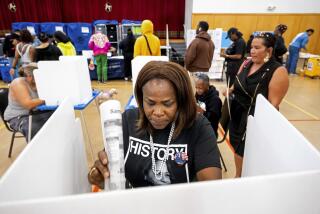The Primary Process Is a Loser : Voting: The GOP might have found a winner if ballots could be marked to rate candidates’ acceptability.
- Share via
The Republican primary wasn’t half over when Bob Dole was acclaimed his party’s choice. Yet Republican voters all across the country were less than excited. In California, 21% told a Times poll Tuesday that they probably will defect to President Clinton in November.
Is Dole really the best candidate the Republicans can offer? Probably not. But he will be nominated because the primary system is set up wrong. And if he loses in November, as seems likely, the party will be leaderless--a situation that opens the window of opportunity to rethink the primary system.
The party’s interest is in having a winner, which, almost by definition, means a candidate with high positives. As now organized, campaigning in a contested presidential primary is an endurance test of negatives; each candidate must tear down every opponent in order to remain viable. The voters are told to think strategically about who is most electable or what message they want to send; they’re not asked who they would be happy to have as their party’s candidate. What the party gets out of this process is a garbled message from the voters and a candidate too bruised to be a likely winner.
The problem is that the voters don’t really have much of a say. They get one chance to select one candidate. That’s fine if it’s a two-person contest. But if there is a field of candidates, those on the fringe can easily emerge as strong contenders, even front-runners, as broadly acceptable candidates split the moderate majority vote between them. In fact, broadly acceptable candidates were splitting a smaller field of support before this year’s Republican primaries began, so some of the more promising candidates were eliminated very early. Because the widely acceptable candidates are fighting for the same votes, big advances happen when one edges ahead because of better organization or is anointed to unify the party.
What if the party were able to hold together, keep its momentum and still have a good look at the best candidates? It’s possible if the primaries are recast to ask voters a different question: Which of the candidates is acceptable?
Voters should be permitted as many votes as there are candidates on the ballot. Voters would be free to cast only one vote if they felt strongly committed to one candidate, several if they liked some aspects of several candidates or conceivably all of them as an ultimate act of fence-straddling. In no case could more than one vote be cast for a single candidate. Voters would need to think strategically about the extent that they would dilute the potency of their vote by choosing two or more candidates. But they would no longer need to make a forced choice between equally acceptable (or unacceptable) ones based on too little information, especially early in the primary season.
This procedure, called approval voting, was tried successfully in Pennsylvania some years ago. It didn’t last, because people who have won office the old way are not inclined to change what works for them. After November, the Republican Party might see the logic in approval voting.
Approval voting has many advantages for the presidential primary process. Most important, candidates having similar appeal would be able to retain their base of support without the division created by the forced choice system. Contenders would be motivated to campaign in a more positive fashion, needing to broaden their appeal, rather than trying to divide the opposition in hopes of gaining an edge with narrow-based support. Candidates’ acceptability quotient could be determined with greater certainty as the most viable leaders are reaffirmed throughout the primary process. The early primaries would narrow the field by eliminating extremists, because being approved on 25% to 30% of the ballots is no match for the more broadly acceptable candidates each getting 50% to 70% or more approval.
Those voting later in the campaign would pick from a narrower field of electable candidates, rather than having a narrow choice among, say, a less than exciting party elder, an extremist and a tag-along billionaire. The party would not have to worry about disunity because the real contenders would be fighting for higher and higher approval, bringing the party together, rather than fighting off extremists at every turn. The convention would then be a place for real discussion about the heart and soul of the party. The finalists, each having broad appeal, could argue about popular ideas to differentiate themselves, and extremists would be marginalized players rather than spoilers.
More to Read
Get the L.A. Times Politics newsletter
Deeply reported insights into legislation, politics and policy from Sacramento, Washington and beyond. In your inbox twice per week.
You may occasionally receive promotional content from the Los Angeles Times.










